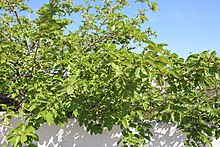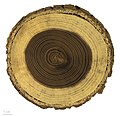
The Moraceae—often called the mulberry family or fig family—are a family of flowering plants comprising about 38 genera and over 1100 species. Most are widespread in tropical and subtropical regions, less so in temperate climates; however, their distribution is cosmopolitan overall. The only synapomorphy within the Moraceae is presence of laticifers and milky sap in all parenchymatous tissues, but generally useful field characters include two carpels sometimes with one reduced, compound inconspicuous flowers, and compound fruits. The family includes well-known plants such as the fig, banyan, breadfruit, jackfruit, mulberry, and Osage orange. The 'flowers' of Moraceae are often pseudanthia.

A birch is a thin-leaved deciduous hardwood tree of the genus Betula, in the family Betulaceae, which also includes alders, hazels, and hornbeams. It is closely related to the beech-oak family Fagaceae. The genus Betula contains 30 to 60 known taxa of which 11 are on the IUCN 2011 Red List of Threatened Species. They are a typically rather short-lived pioneer species widespread in the Northern Hemisphere, particularly in northern areas of temperate climates and in boreal climates. Birch wood, the wood of the birch, is used for a wide range of purposes.

Morus, a genus of flowering plants in the family Moraceae, consists of diverse species of deciduous trees commonly known as mulberries, growing wild and under cultivation in many temperate world regions. Generally, the genus has 64 subordinate taxa, three of which are well-known and are ostensibly named for the fruit color of the best-known cultivar: white, red, and black mulberry, with numerous cultivars and some taxa currently unchecked and awaiting taxonomic scrutiny. M. alba is native to South Asia, but is widely distributed across Europe, Southern Africa, South America, and North America. M. alba is also the species most preferred by the silkworm, and is regarded as an invasive species in Brazil and the United States.

Rosa rugosa is a species of rose native to eastern Asia, in northeastern China, Japan, Korea and southeastern Siberia, where it grows on beach coasts, often on sand dunes. It should not be confused with Rosa multiflora, which is also known as "Japanese rose". The Latin word "rugosa" means "wrinkled", referring to the wrinkled leaves. Often used as an ornamental plant, it has become invasive in parts of Europe, North America and South America.

Magnolia tripetala, commonly called umbrella magnolia or simply umbrella-tree, is a deciduous tree native to the eastern United States in the Appalachian Mountains, the Ozarks, and the Ouachita Mountains. The name "umbrella tree" derives from the fact that the large leaves are clustered at the tips of the branches forming an umbrella-shaped structure.

Rapid plant movement encompasses movement in plant structures occurring over a very short period, usually under one second. For example, the Venus flytrap closes its trap in about 100 milliseconds. The traps of Utricularia are much faster, closing in about 0.5 milliseconds. The dogwood bunchberry's flower opens its petals and fires pollen in less than 0.5 milliseconds. The record is currently held by the white mulberry tree, with flower movement taking 25 microseconds, as pollen is catapulted from the stamens at velocities in excess of half the speed of sound—near the theoretical physical limits for movements in plants.

Annona squamosa is a small, well-branched tree or shrub from the family Annonaceae that bears edible fruits called sugar apples or sweetsops. It tolerates a tropical lowland climate better than its relatives Annona reticulata and Annona cherimola helping make it the most widely cultivated of these species. Annona squamosa is a small, semi-(or late) deciduous, much-branched shrub or small tree 3 to 8 metres tall similar to soursop. It is a native of tropical climate in the Americas and West Indies, and Spanish traders aboard the Manila galleons docking in the Philippines brought it to Asia.
Chinese mulberry is a common name for several trees and may refer to:

Yucca filamentosa, Adam's needle and thread, is a species of flowering plant in the family Asparagaceae native to the southeastern United States. Growing to 3 metres tall, it is an evergreen shrub valued in horticulture.
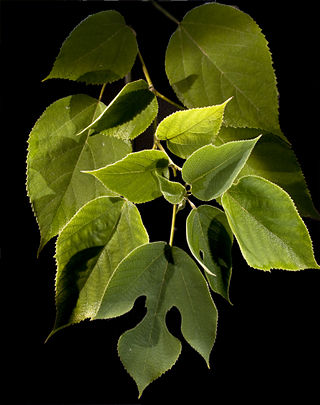
The paper mulberry is a species of flowering plant in the family Moraceae. It is native to Asia, where its range includes Taiwan, mainland China, Japan, Korea, Southeast Asia, Myanmar, and India. It is widely cultivated elsewhere and it grows as an introduced species in New Zealand, parts of Europe, the United States, and Africa. Other common names include tapa cloth tree.

Morus rubra, commonly known as the red mulberry, is a species of mulberry native to eastern and central North America. It is found from Ontario, Minnesota, and Vermont south to southern Florida, and west as far as southeastern South Dakota, Nebraska, Kansas, and central Texas. There have been reports of isolated populations in New Mexico, Idaho, and British Columbia.

Raphanus raphanistrum, also known as wild radish, white charlock or jointed charlock, is a flowering plant in the family Brassicaceae. One of its subspecies, Raphanus raphanistrum subsp. sativus, includes a diverse variety of cultivated radishes. The species is native to western Asia, Europe and parts of Northern Africa. It has been introduced into most parts of the world and is regarded as a habitat threatening invasive species in many areas, for example, Australia. It spreads rapidly and is often found growing on roadsides or in other places where the ground has been disturbed.

Aesculus californica, commonly known as the California buckeye or California horse-chestnut, is a species of buckeye native to California and southwestern Oregon.
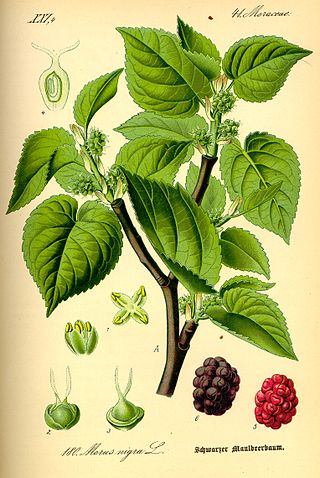
Morus nigra, called black mulberry, is a species of flowering plant in the family Moraceae that is native to southwestern Asia, where it has been cultivated for so long that its precise natural range is unknown. The black mulberry is known for its large number of chromosomes.

Prunus mahaleb, the mahaleb cherry or St Lucie cherry, is a species of cherry tree. The tree is cultivated for a spice obtained from the seeds inside the cherry stones. The seeds have a fragrant smell and have a taste comparable to bitter almonds with cherry notes.
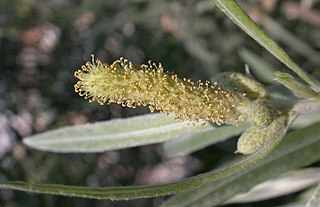
Salix exigua is a species of willow native to most of North America except for the southeast and far north, occurring from Alaska east to New Brunswick, and south to northern Mexico. It is considered a threatened species in Massachusetts while in Connecticut, Maryland, and New Hampshire it is considered endangered.

Betula occidentalis, the water birch or red birch, is a species of birch native to western North America, in Canada from Yukon east to Northwestern Ontario and southwards, and in the United States from eastern Washington east to western North Dakota, and south to eastern California, northern Arizona and northern New Mexico, and southwestern Alaska. It typically occurs along streams in mountainous regions, sometimes at elevations of 2,100 metres and in drier areas than paper birch.

Corylus americana, the American hazelnut or American hazel, is a species of deciduous shrub in the genus Corylus, native to the eastern and central United States and extreme southern parts of eastern and central Canada.

Morus indica is a member of the genus Morus, of the family of flowering plants Moraceae, commonly known as the mulberry family. As with other mulberries, Morus indica is a deciduous tree. Morus indica is native to the temperate and sub-tropical Himalayan region. It is currently cultivated in India, China, Japan, and East Africa.

Morus mongolica, also described as Morus alba var. mongolica, is a woody plant native to mountain forests in Mongolia, China, Korea, and Japan. Common names include Mongolian mulberry, meng sang (China), and ilama by native people in the namesake region of Mongolia. Similar to M. notabilis, M. mongolica is an uncultivated mulberry.
